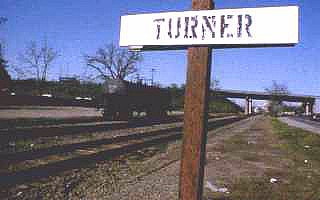Tidewater
Southern

Page 3
Trails
To Rails
In the Beginning were two small Central
Valley start-up transportation companies: the Tidewater & Southern
Railroad Company and the Tidewater & Southern Transit Company. On March
11, 1912 these two Tidewater & Southerns decided they had more in common
than not and merged to form a single new company: The Tidewater Southern.
The new company's investors (like so
many budding "empire builders" of the time) were anxious to put the monolithic
Southern Pacific in its place by offering local farmers, ranchers and merchants
alternative transportation to ship goods out of the Central Valley. So
hated, in fact, was the SP by some that over-zealous investors would preach
how the new railroad would free farmers from the yoke of high tariffs and
poor service; if just for a small investment!
Original company plans called for the
construction of over 150 miles of electrified trackage to connect Stockton
with the booming town of Fresno, in the southern San Joaquin Valley. And
true visionaries talked of laying track beyond Fresno to Southern California
to connect with the Ventura County Railroad at Oxnard.
Unfortunately, in spite of their lofty
goals the Tidewater's construction crews never built beyond the tiny dairy
town of Hillmar, just over the Merced County Line.
|
What's
In A Name?
The
station of Turner is the first siding out of Stockton, at MP 6.2. Until
its abandonment several years ago, Manteca Junction at MP 5.2 held that
distinction.
Original
WP era station signs still graced many TS locations up through the early
1990s. As of 2001, however, the sign at Turner appears to be the sole survivor.
The westbound side is still readable while the eastbound side is faded
beyond recognition. (Ken
Rattenne Photo)
|
When the twin Tidewater companies merged
to build a common railroad it seemed natural only natural to drop the ampersand
(&) from their former shared names and christan the new pike the Tidewater
Southern.
As with most shortlines, the Tidewater
Southern took its name for the geography in ran through: Tidewater for
the tidewaters of the San Joaquin River delta in thePortt of Stockton,
and Southern for the geographical direction the line takes through the
Valley (though no doubt the founding officers were thinking in bigger terms).
By October of 1912, the route was opened
for the 30.1 miles between Stockton and North Junction in Modesto. That
same year the railroad initiated Interurban service in Stockton, carrying
passengers between the waterfront and Ortega at MP 1.7, just south of Western
Pacific's Stockton yard. In those early days the Tidewater shared a terminal
with the Central California Traction Company, which had a depot downtown
at Taylor Street.
After leaving the waterfront Tidewater
trains arrived at the downtown station on Taylor Street. To get to Ortega
and gain access to its own line Tidewater trains had to use tracks belonging
to the Stockton Electric then cross the SP and WP mainlines at grade using
tracks originally constructed by WP predecessor Alameda & San Joaquin. |
Line crews were kept busy between May
and November of 1913 erecting trolley poles and stringing catenary wire
between them electrifing the mainline by
It was a bright day for TS President
Byron Bearce when the first train of Jewett cars rolled up to the Stockton
depot to inaugurate Interurban service on November 15th, 1913. Painted
in the standard Pullman Green typical of the era, the Jewetts were scheduled
to operate three round trips a day, making the 33 mile run between Stockton
and Modesto in an hour and twenty-five minutes This beat SP's running time,
which operated trains every four hours, by 15 to 20 minutes. (By
contrast, the same trip today takes only about 25 minutes on State Highway
99).
In those embryonic days, the Tidewater
owned three Jewell combination cars and a solitary electric freight locomotive,
numbered 100, and constructed from a flat car at the Central California
Traction shop in Stockton.
The railroad opened the 16.3 miles of
route between Modesto and Turlock in July of 1916, then eight miles between
the station of Hatch (at milepost 41.6) and Hilmar (milepost 49.8) in 1917.
This was as far as the railroad's southward expansion would reach, about
100 miles shy of its hoped-for destination of Fresno. While the railroad
planned to electrify the Turlock line, it never occurred. In May of 1918,
not long after inclusion into Western Pacific's family, the TS constructed
a branch just 5.2 miles south of Stockton, at Manteca Junction. The Manteca
Branch stretched its finger of track 6.6 miles into the town of Manteca
to a location known simply as South Manteca.
Eventually, the main line was cut back
from Hilmar to Chemurgic, at milepost 44.5, creating the 2.9 mile Chemurgic
Branch. Because of hefty carloadings in Turlock (and the SP interchange
located there) the "Turlock Branch" became the main line while the old
mainline to Hilmar became a branch.




